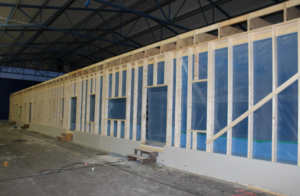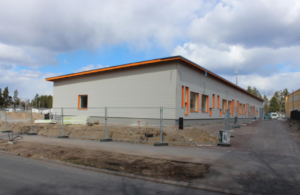Approximately 200 children in Hyvinkää (Finland) attend the first Nordic Swan eco-labeled pre-school building in Finland. Building this nursery took one year and cost about 6,5 million euros. Inkeri Kontiola, procurement specialist in Hyvinkää City municipality, is convinced that this experience will make similar procurements much easier.
Different approach
A common problem in various municipalities is that there are just few people in charge for public procurement. Therefore it is sometimes difficult to find enough time and motivation to put additional effort into finding unconventional solutions. Procurement specialist I. Kontiola proves that it requires some but not too much additional effort to adopt an unconventional approach. She shared her experience in the international seminar ‘Reduction of hazardous substances from urban sources – strategies, tools and incentives municipalities can implement’, organised by the partners of the project “Innovative management solutions for minimizing emissions of hazardous substances from urban areas in the Baltic Sea Region” (NonHazCity).
‘In our municipality we have three people responsible for public procurement, so it is not a big organisation. I personally was given a task to think of new ways of how we build municipality owned buildings. We wanted to emphasize the environmental and health issues from the prospective of the building itself as well as looking at the health of children and our staff. The cost of energy was also an important environmental and financial aspect. That is why I was asked to do something different and to find new ways of procuring this building’, – says Inkeri Kontiola.
Several steps
The main focus points of this procurement process was not only to ensure a reasonable energy consumption, but also to have a healthy, comfortable and versatile building for its users. Other factors that were considered were the new national legislation on pre-school care and the municipal environment strategy.
The first step of this procurement was to make a decision to emphasize environmental issues. By doing that, health issues are addressed, municipal environmental guidelines are supported, energy and maintenance costs are low in the long run. Furthermore it offers opportunities for building constructors to offer solutions that integrate alternative/innovative energy sources, construction methods and materials and lastly, it creates an excellent marketing and image value to the city.
In a second step, Hyvinkää published a request for information on the national tender website. They asked interested parties for suggestions on saving energy methods and new innovative building materials and techniques. Four, but very sketchy responses were submitted and therefore Hyvinkää decided to send a second more detailed questionnaire. And also individually meet up with the different producers to clarify specific issues.
Step three was the actual procurement. The call for tenders was published in Tenders Electronic Daily. The selection criteria were the price (50 %) and qualitative measures (50 %) which included amongst others criteria on the façade, indoor layout, and eco labels.


Valuable lessons
Inkeri Kontiola says that the municipality has learned a couple of valuable lessons from this tender and when asked what she would advise she mentioned:
- Set yourself a target: what is the end result aimed for.
- Take advantage of the possibility to launch a request for information, meet with potential tenderers.
- Use standards (ISO/EU) or certificates.
- Build your invitation to tender in a way that it can accommodate criteria such as EU green public procurement criteria or eco-labels.
- Plan sufficient time for the procurement process.
- Take into account that the procurement costs might be slightly higher.
Inkeri says: ‘The actual procurement did cost a bit more. When you try something new it almost always costs a bit more. However we knew that the eco-label criteria guarantees that the life cycle costs will be less than they would normally be. We were thinking about the future. After this tender we consider similar projects, of course. The process was time consuming but now that we have done it and have the experience, it will be much easier next time.’
A challenge for builders
The company that won the tender is called ‘Teijo-Talot’. They construct buildings inside a factory from foundation to the top of the chimney. ‘Teijo-Talot’ already had a waste-recycling system and a wide knowledge of materials and chemicals.
However, the representative of the company Heidi Karlsson admits that the company had difficulties fulfilling this task. She mentioned that some criteria were hard to understand; some suppliers did not want share information and some products were hard to replace or were very expensive. The timetable was tight and all of this had to be done in quite a short period of time. In the end, it was possible thanks to the good connections to suppliers and committed workers, subcontractors and foreman.
Although there were some difficulties along the way, the building was completed on time. This was achieved by choosing the subcontractors very carefully and allowing enough time. Not choosing the easiest options based on the price has clearly paid off in Hyvinkää.

